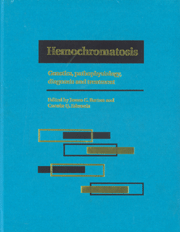Book contents
- Frontmatter
- Contents
- List of contributors
- Foreword
- Part I Introduction to hemochromatosis
- Part II Genetics of hemochromatosis
- Part III Metal absorption and metabolism in hemochromatosis
- 10 Intestinal iron-binding proteins
- 11 Intestinal iron absorption and hemochromatosis
- 12 The absorption and metabolism of non-ferrous metals in hemochromatosis
- 13 Ferritin metabolism in hemochromatosis
- 14 Hepatic iron metabolism in hemochromatosis
- 15 Extra-hepatic iron metabolism in hemochromatosis
- 16 Mathematical models of metal metabolism in hemochromatosis
- 17 Expression of iron overload in hemochromatosis
- Part IV Diagnostic techniques for iron overload
- Part V Complications of iron overload
- Part VI Therapy of hemochromatosis and iron overload
- Part VII Infections and immunity in hemochromatosis
- Part VIII Hemochromatosis heterozygotes
- Part IX Relationship of hemochromatosis to other disorders
- Part X Animal models of hemochromatosis and iron overload
- Part XI Screening for hemochromatosis
- Part XII Hemochromatosis: societal and ethical issues
- Part XIII Final issues
- Index
14 - Hepatic iron metabolism in hemochromatosis
from Part III - Metal absorption and metabolism in hemochromatosis
Published online by Cambridge University Press: 05 August 2011
- Frontmatter
- Contents
- List of contributors
- Foreword
- Part I Introduction to hemochromatosis
- Part II Genetics of hemochromatosis
- Part III Metal absorption and metabolism in hemochromatosis
- 10 Intestinal iron-binding proteins
- 11 Intestinal iron absorption and hemochromatosis
- 12 The absorption and metabolism of non-ferrous metals in hemochromatosis
- 13 Ferritin metabolism in hemochromatosis
- 14 Hepatic iron metabolism in hemochromatosis
- 15 Extra-hepatic iron metabolism in hemochromatosis
- 16 Mathematical models of metal metabolism in hemochromatosis
- 17 Expression of iron overload in hemochromatosis
- Part IV Diagnostic techniques for iron overload
- Part V Complications of iron overload
- Part VI Therapy of hemochromatosis and iron overload
- Part VII Infections and immunity in hemochromatosis
- Part VIII Hemochromatosis heterozygotes
- Part IX Relationship of hemochromatosis to other disorders
- Part X Animal models of hemochromatosis and iron overload
- Part XI Screening for hemochromatosis
- Part XII Hemochromatosis: societal and ethical issues
- Part XIII Final issues
- Index
Summary
Introduction
As a major site of iron storage under normal circumstances, the liver bears a disproportionate share of the burden of increased body iron in hemochromatosis. Storage iron normally accounts for 20–30% of total body iron, or about 1 g in an average adult man. Of this, approximately 25% is deposited in the liver. Thus, in normal individuals, hepatic iron concentrations range from 500 to 1500 μg/g dry weight. In hemochromatosis, hepatic iron concentrations can exceed the upper limit of this range by more than 20-fold, reflecting the dramatic expansion in iron stores.
Excessive absorption of dietary iron on a chronic basis produces a characteristic pattern of hepatic iron deposition. In hemochromatosis, the parenchymal cells of the liver are the primary sites of iron accumulation, whereas in secondary iron overload and in parenteral iron overload, iron deposition is found in Kupffer cells and in hepatocytes. Iron deposition in hemochromatosis is first evident in periportal hepatocytes (acinar zone 1 of Rappaport), but with progressive iron loading involves hepatocytes of zones 2 and 3. As a consequence, a decreasing portal to central gradient of hepatocellular iron is observed. At the cellular level, granules containing iron are localized along the pericanalicular aspect of the siderotic hepatocytes and thus outline bile canaliculi. Morphological and biochemical data indicate that these granules are iron-laden lysosomes. As hepatic iron increases, there is deposition of iron in the mesenchymal structures of the portal tracts (bile ducts, connective tissue, vascular walls, etc.). Although cell necrosis and inflammation are not conspicuous features of hemochromatosis, sinusoidal iron deposits that are presumed to result from phagocytosis of necrotic iron-loaded hepatocytes by Kupffer cells are also seen with heavy iron loading.
- Type
- Chapter
- Information
- HemochromatosisGenetics, Pathophysiology, Diagnosis and Treatment, pp. 157 - 162Publisher: Cambridge University PressPrint publication year: 2000
- 3
- Cited by



